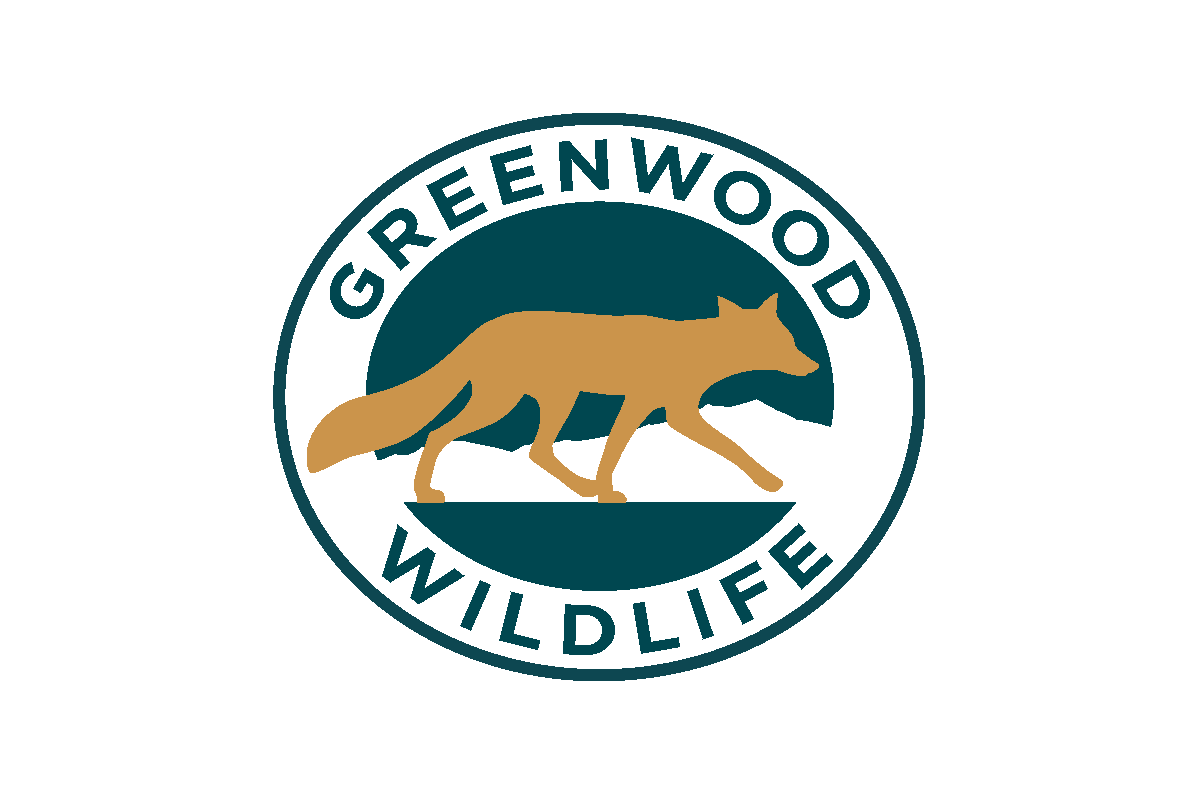Over 140 different species came to the Center for care in 2022. Some are widespread in our urbanized environment, while others struggle to adapt to available habitats. As a wildlife rehabilitation center, Greenwood is an essential resource for many Colorado species, including those of concern. Also, we strive to help limit the spread of diseases in the wild.
To honor World Wildlife Day on March 3rd, we hope to raise awareness about the most vulnerable wildlife in Colorado. Last year, the sensitive species below were cared for at our facility:
Animals Listed Under the Endangered Species Act
Fifty years ago, the Endangered Species Act was signed into law to create a framework that protects wildlife and their habitats. Now, it is one of the most powerful legal tools for conservation. The ultimate goal of this law is to prevent the extinction of imperiled animals and plants through domestic and international regulations.
Yellow-billed Cuckoo*, Coccyzus americanus
Their slim bodies and stealthy behaviors allow the Yellow-billed Cuckoo to hide within deciduous woodlands. This cuckoo is one of few species able to eat hairy caterpillars, sometimes gorging themselves on as many as 100 per meal. They also enjoy other giant insects, such as cicadas. Females lay a single egg, waiting up to five days before the next. This asynchronous system spreads out nourishment requirements. When food is abundant, the cuckoos produce more eggs and allow other bird parents to raise their young. They evolved the ability to lay eggs that mimic other species, like the American Robin, so their young will fit right in. These birds are federally listed as threatened in the Southwest region, including Colorado. Much of their habitat along wooded river banks has been cleared for farming and housing.
*additionally listed as a Bird of Conservation Concern by the U.S. Fish and Wildlife Service.
Colorado’s Species of Greatest Conservation Need:
Colorado’s Wildlife Action Plan creates two tiers for species, reflecting their degree of conservation need. This report outlines vulnerable animals and their habitats in order to address threats and stay proactive in conservation actions. The species listed below are a part of the state’s most recent action plan.
Abert’s Squirrel, Sciurus aberti
Identifiable by their large ear tufts, Abert’s Squirrels live in the mature ponderosa forests of Colorado. This species is considered an indicator for the health of the ecosystem, which means it reflects the current environmental condition of the area. Abert’s show the density of interlocking pine canopies due to their reliance on their cones, needles, and buds. As the only squirrel that does not cache winter snacks, the critters are active year-round, depending on the ponderosa’s sap in the coldest winter months. Their declining population trend parallels the decrease in old-growth forests.
American White Pelican, Pelecanus erythrorhynchos
American White Pelicans are majestic in the skies, soaring gracefully in V-formation. This seabird is one of the largest in North America, with its broad wings, large heads, and heavy bills. Pelicans use these hefty bills to herd and catch fish with their flock. Up to 150 pounds of fish is required to nourish a single baby pelican to adulthood. A yellow vertical prehistoric-like plate develops on the tip of their bills, indicating they are ready to breed. This sensitive species depends on shallow wetland habitats and is known to abandon nests due to human disturbances.
Black-tailed Prairie Dog, Cynomys ludovicianus
Residing in the Colorado foothills and eastern plains, Black-tailed Prairie Dogs burrow underground, creating elaborate tunnels and specialized rooms. As highly social creatures, their communication is sophisticated, from warning calls to daily chats. Threatened by disease and habitat fragmentation, prairie dogs have, unfortunately, lost up to 95 percent of their population. Yet, this species provides many environmental benefits with their digs, including soil fertilization, which improve biodiversity. Additionally, the endangered Black-footed Ferret depends on these critters as a primary food source.
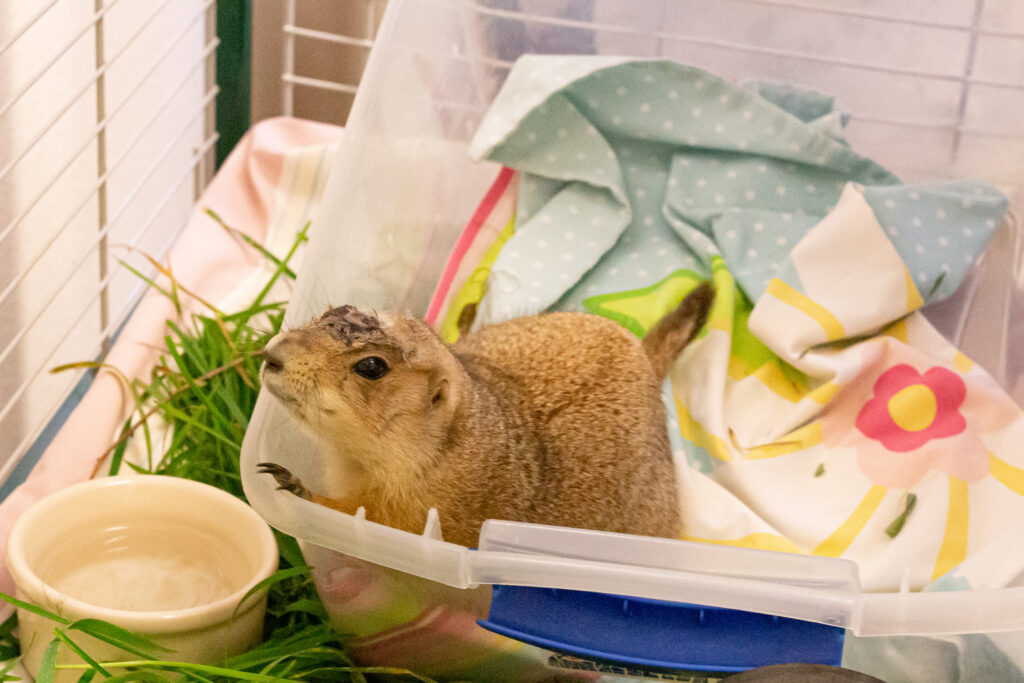
Cassin’s Finch*, Haemorhous cassinii
Cassin’s Finch is the largest of the three North American finches. The Colorado mountains and conifer forests are a permanent home to this rose-crowned finch. Their unique headdress coloration comes from foraging seeds from bright berries. In 2022, only two Cassin’s Finch needed Greenwood’s help, while we saw 300 of their cousins, the House Finch. Seeds and salty snacks are some of their favorite meals. Additional studies are needed to understand the cause of their current decline.
Grasshopper Sparrow* Ammodramus savannarum
Male Lazuli Buntings light up their arid woodland habitats with their gem-blue heads and stained orange chests. Deservingly so, their Latin name means ‘beautiful sparrow.’ Colorado is their summer breeding ground, where they mate in mostly monogamous couples. The males are territorial once paired. The females are strikingly soft in color compared to their counterparts, often seen balancing on small branches for seedy nibbles. Their decline placed this bunting on the state’s conservation priorities.
Lazuli Bunting, Passerina amoena
Grasshopper Sparrow are light-colored birds with minimal markings aside from their neutral-speckled top feathers. This sparrow spends most of their time on the ground when not chasing insects, camouflaged by dense grasslands. True to their name, grasshoppers are their grub of choice. Their quiet song even mimics the vibrations of the insect’s legs. Domed nests are hidden among grass clumps. Unfortunately, their populations are in steep decline due to loss, fragmentation, and degradation of their habitats. Grassland birds are among conservationists’ most significant concern.
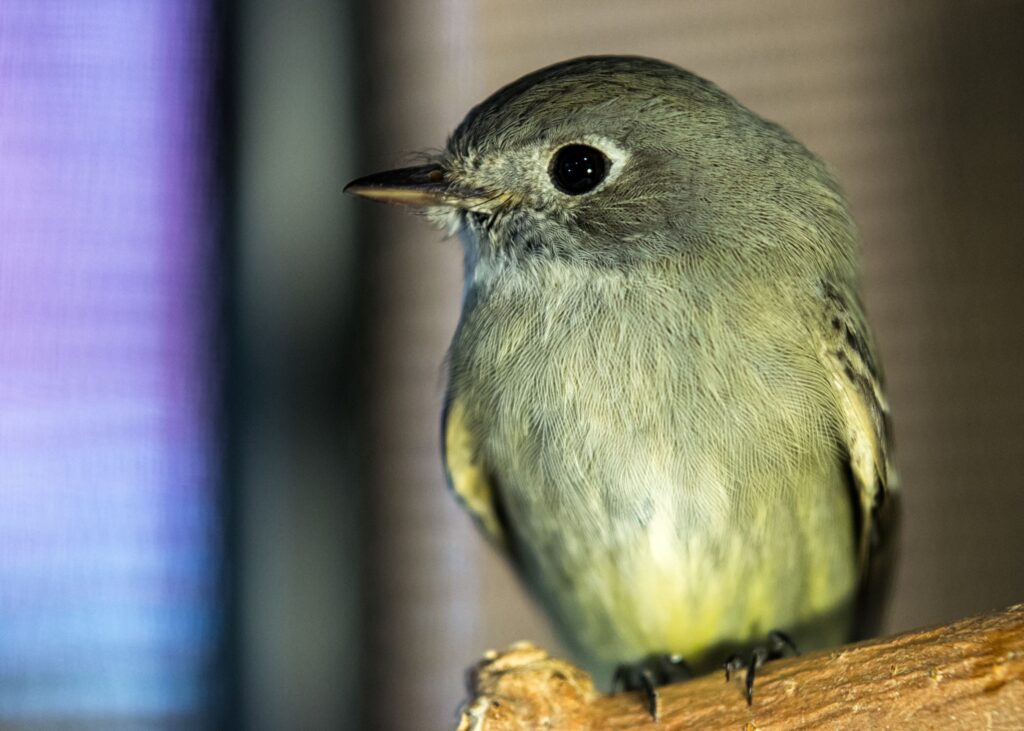
Olive-sided Flycatcher*, Contopus cooperi
Usually found perched in a tree, awaiting their insect prey, the Olive-sided Flycatcher nests in rugged coniferous forests. Dead and burned tree branches are the perfect lookout for their next meal in the skies. This barrel-chested bird wears a vest of grey feathers, and its olive tones shine under direct sunlight. The Olive-sided Flycatcher is considered an ‘on-alert’ species, meaning 50% of their population has been lost since the 1970s. Despite their adaptation to burned areas, winter habitat loss is likely impacting their numbers.
Birds of Conservation Concern in Colorado
The U.S. Fish and Wildlife Service curated the 2021 Birds of Conservation Concern report that identified more than 250 bird species in need. This research aims to prevent these birds’ addition to the Endangered Species Act through awareness and conservation. The 2022 State of Birds report further surveyed these species, labeling 70 birds as ‘tipping point’ species and another 20 ‘on-alert’ species. In both cases, this means 50% of their population has been lost in the last 50 years. Tipping point species also have a trajectory to lose another half of the remaining birds within the next fifty.
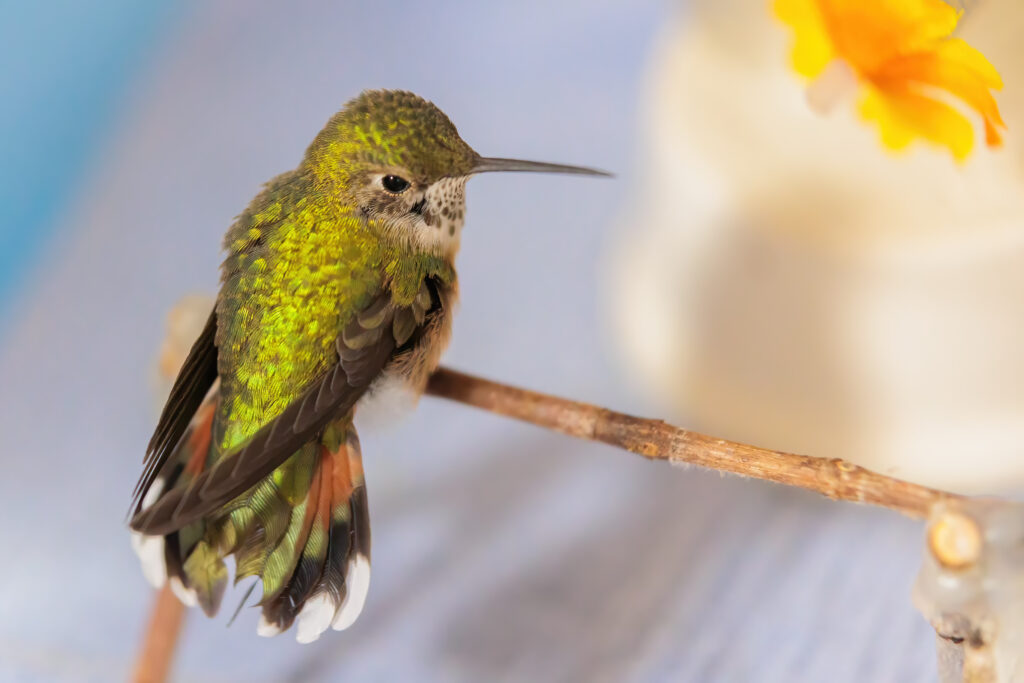
Broad-tailed Hummingbird, Selasphorus platycercus
Despite declining numbers, the Broad-tailed Hummingbird is still widespread across mountain meadows and open forests. Their green metallic wings and broad tailfeathers are a common summertime sight while breeding in the high elevations of Colorado. Darting between wildflower blossoms, hummingbirds are critical pollinators for native plants. Their diet also includes insects for protein. Climate change threatens their fragile alpine breeding ground.
Clark’s Nutcracker, Nucifraga columbiana
As birds of the mountains, the Clark’s Nutcracker holds a mutual relationship with subalpine pine trees. The pine cones evolved to be dispersed by the nutcracker instead of the wind. Between the size of a robin and a crow, these pale gray birds sport black wings and white accent feathers. The nutcracker uses its daggerlike bill to extract seeds from pine cones and buries thousands of these snacks in a winter cache. Additionally, these diligent birds use their bills to check each seed for soundness. The bark beetle epidemic kills the pine trees that the nutcracker depends on for food. Due to their high elevation habitat preferences, climate change also makes this population vulnerable.
Evening Grosbeak, Coccothraustes vespertinus
Known as winter wanderers, the Evening Grosbeak flocks south in sizable masses to enjoy warmer temperatures and forage for seeds and fallen fruits – sometimes causing irruptions to the delight of birdwatchers. This bird exhibits rich yellow feathers across its body and around its eyes. During the summer months, these grosbeaks breed in the mature coniferous forests of the Colorado Rockies. Platform feeders are the best way to attract these colorful birds. Evening Grosbeaks are considered a ‘tipping point’ species. Potential causes include tar sands development, pesticide use, and other human disruptions.
Franklin’s Gull, Leucophaeus pipixcan
The Franklin’s Gull slowly migrates through the Central Flyaway, which includes Colorado, on route to the Peruvian coast for the winter. During breeding season in Canada, a rose-tinged plumage appears on the underbellies of adults. These seabirds forage in flight, plucking up their prey on the water’s surface. They call the prairie wetlands and open marshes home. Their floating nests require daily upkeep by the parents and older chicks until migration when the material sinks to the bottom of the marshes. As an aquatic species, wetland drainage and water pollutants take a toll on these birds, adding them to the watch list.
Western Grebe, Aechmophorus occidentalis
Most of Colorado is made up of Western Grebe’s breeding grounds. These waterbirds are known for their elegant courtship dance in which males and females dash across the water together with their necks curved in an S-shape. Rarely venturing ashore, grebes depend on wetland habitats, such as lakes and ponds. Their sole food sources are fish and other aquatic species, like salamanders and crustaceans. They jab their prey with their sharp bills. Dense waterproof plumage allows them to adjust their buoyancy in the water, sometimes only revealing their heads. The Western Grebe is another ‘on-alert’ species due to its sensitivity to pesticides and other habitat degradation from oil spills and abandoned fishing equipment.
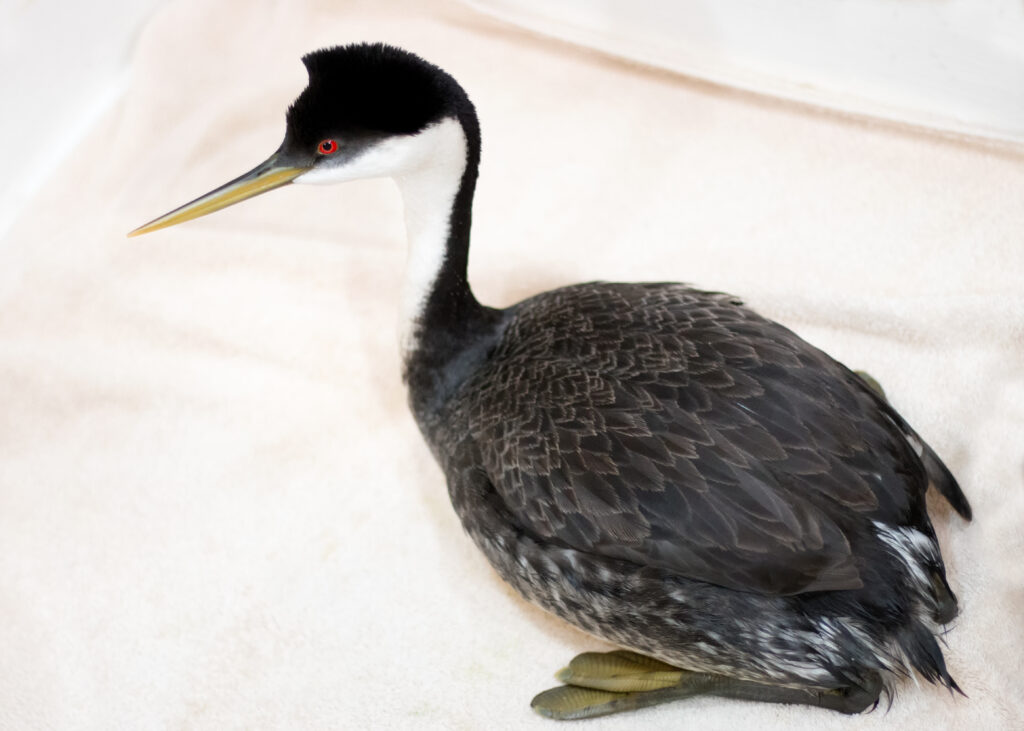
Greenwood’s mission is to rehabilitate and release orphaned, injured, and sick wildlife and educate the community on humane wildlife solutions. We hope to create a positive impact for these sensitive species and contribute to their continued conservation.
Sources
‘Abert’s Squirrels.’ Rocky Mountain National Park, National Park Service. March 2012.
All About Birds. Cornell University, 2022.
‘Birds of Conservation Concern 2021.’ Migratory Program, U.S Fish and Wildlife Services April 2021.
‘Prairie Dogs.’ Colorado Parks and Wildlife.
‘State Wildlife Action Plan.’ Colorado Parks and Wildlife. 2015.
